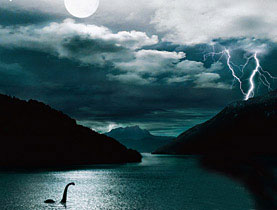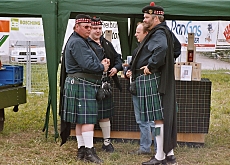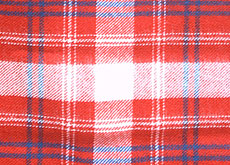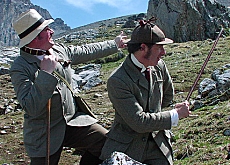How a monster builds bridges

Mountains, monsters – and whisky: three of the things which link Switzerland and Scotland, although not everyone knows it.
But the Scots at least should soon be better informed after a party of home journalists visited Switzerland last week to investigate rumours that their famous Loch Ness monster had been kidnapped by the Swiss.
Nessie featured in a poster campaign by the Swiss Federal Railways earlier this year, showing her surfacing in Lake Lucerne. There was consternation and indignation in some of the Scottish tabloid press, who accused Switzerland of purloining a Scottish monster for their own marketing purposes.
The visitors’ first port of call was naturally the lake where she had been spotted. No-one was exactly sure how to lure her – shouts of “free whisky” didn’t do the trick. Opinions were divided as to whether she was there at all, and if she was, what she thought of it.
“Nessie will always want to go home if she’s here,” Paul Breen, group editor of the Inverness-based Highland News Group assured swissinfo. “Perhaps someone with too much schnapps has seen her here. Certainly we’ve had instances at home where over-indulgence in whisky has seen Nessie crop up.”
Leanna MacLarty of the Press and Journal Newspaper in Aberdeen was equally sure of Nessie’s patriotism.
“I don’t think we should worry too much that Nessie’s found her way over here and that she’s going to stay. She might come over for the odd holiday, but I think she’s firmly in place in Loch Ness,” she said.
But Gabriela Battaglia of Switzerland’s tabloid Blick newspaper, which has taken a great interest in the Nessie story, thought the monster was enjoying herself.
“I’m absolutely convinced that Nessie likes it here, and after so many years in Scotland I think she needs a little break.”
Working like clockwork
Whether or not the monster is revelling in a break in Switzerland, the Swiss Federal Railways certainly believe her compatriots could find plenty to enjoy.
Kurt Metz, a communication consultant who organised the trip on behalf of the railway company, explained to swissinfo the thinking behind the invitation to the journalists.
“We hope they will realise that Switzerland is not only a place where public transport works like clockwork, but that there is also a lot of enjoyment to be had in being driven around, that the variety of what we have to offer as a tourist destination is much bigger than they think and that we can match Scotland with what we have to offer.”
In a tightly planned schedule the journalists were whisked by train, boat and bus through spectacular countryside, from the lakes of central Switzerland, through the Bernese Oberland and down to Lake Geneva.
The transport system lived up to its reputation. “How much easier it is to organise your day if the transport runs well,” MacLarty commented.
Plenty in common
Perhaps an efficient transport system is not something the two countries share, but otherwise they have more in common than many people think.
“There’s a very strong connection between Switzerland and Scotland, which I don’t think many people realise,” said Leah Williamson, of Highland Life Magazine. “When they come here, I think they’ll feel very much at home.”
It’s not just the mountains and the lakes. The Scots were introduced to the William Tell story at the museum in the hero’s home village of Burglen at the southern end of Lake Lucerne, and immediately made the connection with their own legendary freedom fighter, William Wallace.
They visited the Sherlock Holmes museum in Meiringen: Edinburgh-born Arthur Conan-Doyle knew the town well and had his famous detective die by falling over the nearby Reichenbach Falls.
They wandered down the dramatic Aare gorge, looking for Switzerland’s own answer to Nessie: the tatzelwurm – which proved equally elusive. But the towering cliffs, in places only one metre apart, and the impressive walkway built out on struts over the rushing water were as breathtaking as any monster.
Whisky galore!
And perhaps most unexpected of all: the whisky connection.
The sceptical group travelled up to the Jungfraujoch in the Bernese Oberland, one of Switzerland’s chief tourist attractions. It is well known as Europe’s highest railway station, at 3,454 meters. In addition to stupendous views over Switzerland’s longest glacier, the Aletsch, it features an ice palace, full of gleaming sculptures visited by everyone who goes to the Jungfrau.
But an unobtrusive door near the entrance to the palace reveals a flight of stairs leading up to an ice cavern.
And inside that is an ice bar – and in a niche in the ice wall are three barrels of maturing Highland malt whisky. They have been brought up from Rugenbräu brewery near Interlaken, and their contents are very exclusive: limited to 859 bottles.
The Scottish guests were allowed to sample it. Breen summed up the general reaction.
“It’s astonishing. You’ve taken our monster, you’ve taken our whisky. What next? Is there going to be a Swiss kilt? A Swiss haggis? But it’s very, very pleasant.”
swissinfo, Julia Slater
The Loch Ness monster, nicknamed Nessie, is supposed to inhabit Loch Ness in the Scottish Highlands.
Although the first alleged sighting was in the sixth century, it only became famous in 1933, when two separate sightings were claimed.
A famous photo taken in 1934 was revealed in 1994 to be a hoax.
Repeated investigations since the 1930s have produced no physical evidence of the existence of an unknown animal in the lake.
The tatzelwurm is a mythical monster supposed to live in the mountains of various European countries, including Switzerland.
It is said to have a snake-like body, and two front legs.
A Swiss photographer photographed an alleged tatzelwurm in 1934.

In compliance with the JTI standards
More: SWI swissinfo.ch certified by the Journalism Trust Initiative



You can find an overview of ongoing debates with our journalists here. Please join us!
If you want to start a conversation about a topic raised in this article or want to report factual errors, email us at english@swissinfo.ch.